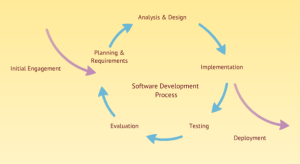 I am attending a two day conference focused on User Experience Design. At the end of the first day I can clearly say this was a valuable event even if every presenter tomorrow is really awful. You can find more information at the conference website (http://www.redesignconference.com/). I will run through the sessions and attempt to communicate those points I found especially poignant. Much of this will be iterative, in that the presenter had a point, I may have heard it as they intended it or applied my own analysis to it. Either way, I should qualify that all of these ideas are not mine but at the same time many of these ideas were not the presenters’. That should be clear as mud!
I am attending a two day conference focused on User Experience Design. At the end of the first day I can clearly say this was a valuable event even if every presenter tomorrow is really awful. You can find more information at the conference website (http://www.redesignconference.com/). I will run through the sessions and attempt to communicate those points I found especially poignant. Much of this will be iterative, in that the presenter had a point, I may have heard it as they intended it or applied my own analysis to it. Either way, I should qualify that all of these ideas are not mine but at the same time many of these ideas were not the presenters’. That should be clear as mud!
What Can Experience Designers Learn From Rock Stars – Tim Richards (@nanotim) – Blitz
Graphic Design and Branding – Andy Gilliland – Punchcut
What We Can Learn From Connected Objects Around Us – Jeff Devries – Motorola Mobility
Learning From James Bond, Experience Designer – Danny Sill – IDEO
What We Can Learn From a Bad Remodel – Steve Tatham – Disney Imagineering
Reframing UX Design as a Profession – Peter Merholz (@peterme) – Groupon
The discussion of group dynamics was very timely as I look at the development of my teams at Oasis Digital. We need to be able to work collaboratively and we need to work solo. A big challenge has been having that solo work fit back into the collaborative effort. We need a shared language to be consistent. Each team member learns to communicate within the team but continues to use that shared language when they work alone. If we push to stay consistent, then individuals can innovate within the language of the team.
We also discussed the need to have the core message down cold. When you know it inside and out then true passion and innovation can shine through. The best musicians will play a piece thousands of times so that they know it completely. That way when they perform they can meet the audience at the experiential level and communicate without worrying about the content. We should know our process and our message without hesitation. If we do that then we can meet our customers where they are and provide them with more valuable service.
We also need to guard against doing it ourselves. Those around us cannot learn if we do not teach them. This is difficult when faced with deadlines and requirements, but if adhered to then the benefits are substantial. In a modern organization we need to be flexible with the parts we play. There are no menial tasks or work that is below us, there is the team and a goal. The team members have a responsibility to all push toward the goal together.
When presenting an idea we need to speak with passion and honesty, we should not apologize for limitations. We need to put our thoughts and ideas out to the world. Good design has persuasive power and we need to master our craft.
There was also discussion about the need to separate the idea from the execution. I like the quote “save yourself from yourself”. Often we can be our own worst enemy and destroy our own ideas. We load them down with requirements and additional ideas which can lead to a loss of the original point. We should iterate on the execution (how the idea is realized), not on the idea itself.
Simple is often the best approach once the shared language of the team is established. You should be able to distill core ideas to fit on a bumper sticker. This is not sales, it is communication. This flows into another point that was made which was we should design for behavior instead of designing for information. The ways users are interfacing with information are distributed across platforms and devices. We should be looking at the behavior in each context.
When a music artist wants the audience to “go nuts” they “drop the bass”. This is a universal message that invites the audience to participate. You can hear this principle in much of the music played during warmups at sporting events. A lot of dance music will make heavy use of this idea as well. As designers we should “drop the bass” in our systems. No, we should not incorporate Dubstep into our designs, we should invite users to use our software. We can do this through emphasis, colors, and simplicity.
The merger of structural thinking and visual aesthetics is very important. We need to give content form and order. There is currently a convergence of physical spaces and screen spaces. A convergence of physical and electronic devices. We should start designing using good design principles and stop just putting the logo in the upper left.
Other design disciplines can teach us a lot. Industrial and Automotive design can teach us about feedback, the prioritization of information and sightless interaction. Landscape architecture can teach us about designing for space, considering flow and managing multiple user interactions. These are very important as we bridge the physical and the virtual. We can use these ideas to develop a consistent design experience that transcends interface options.
The way we store masses of information has changed the way we think and process. The way we use all of this input and store it outside of ourselves is a phenomenal change and we are only scratching the surface of its implications. We need to consider this change as we design a UI. Users today simply interact with applications differently than they did 5, 10 or 20 years ago. We will not be going back so we need to look forward.
We need to think from a systems perspective. We can learn a lot from systems that work (subways, ecosystems, beehives). We should not try to reproduce the same experience on different devices. We should make the experience make sense in the context of the use. This context changes between travel, home and work. There is a progression of interactions that is changing over time (keyboard/mouse > touch/voice > gestures/eye-gaze). These changes are additive, because we now use voice does not mean we stop using a touchpad or mouse.
Society keeps swinging between many devices and a singular multipurpose device. Not too long ago we all had phones, mp3 players, gps devices, etc. Now most adults have a smartphone and none of the rest. With the advent of the new physical devices (fitness tracker, smart watch, Google Glass) will these collapse into a singular device or will they have enough value on their own to persist?
Reverse mentoring can be powerful. Today, youth are coming in with skills and understanding that surpass those with experience in some very critical and narrow areas. Much like teachers had to move from being the knowledge experts in schools to guiding exploration by students we need to empower young coworkers to share what comes so natural to them. We need to adopt that role of guide to help them where they need it (most functional aspects of life), and not be threatened by their skills.
All developers should be concerned with the user experience. This is not the domain of an isolated team member. There is a shortage of designers so companies tend to use their design capacity for product execution and forget ideation and product definition. A good UX designer becomes a conductor and leader for the team. It is very easy for a team to get off the “good” path.

